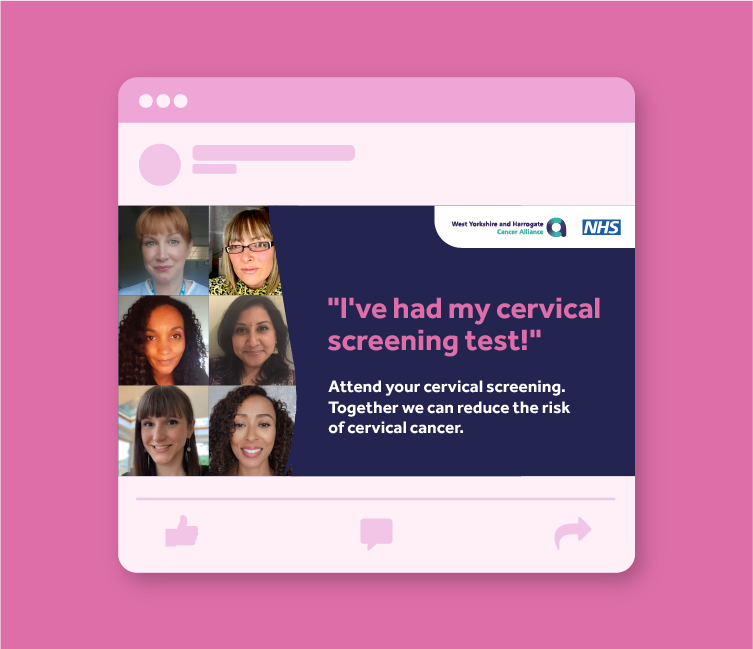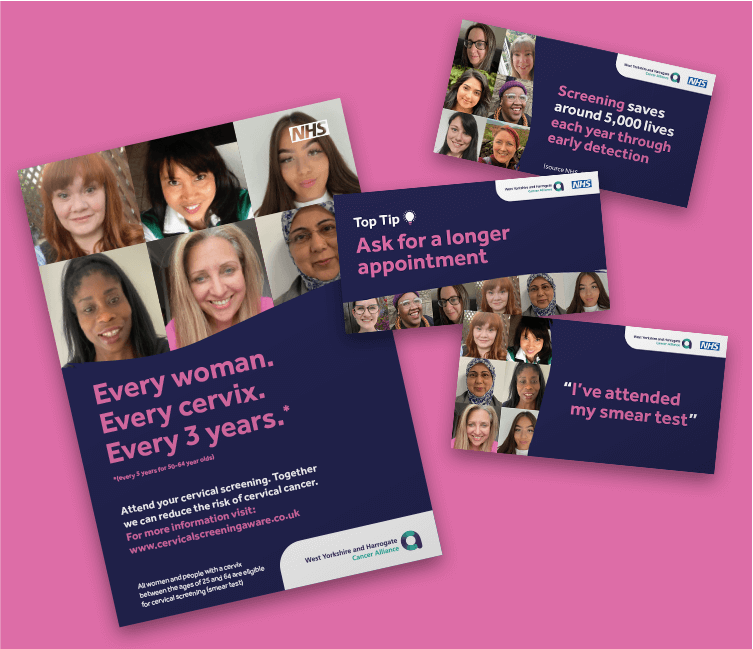Every woman.
Every cervix.
Every 3 years.*
Attend your cervical screening.
Together we can reduce the risk of cervical cancer.
About cervical screening (smear)
Let’s be honest – having your cervix checked by a total stranger is no-one’s idea of fun! It’s intimate, a bit awkward and can be slightly uncomfortable. 3 in 4 people will attend their screening which saves around 5,000 lives every year through early detection and prevention of cancers.
Cervical screening (smear test) checks the health of your cervix. The cervix is the opening to your womb from your vagina. It’s a test to help prevent cervical cancer. The test checks for human papilloma virus (HPV) infection and changes in cells in the neck of your womb. These changes could later develop into cervical cancer, if they are not treated.
Cervical cancer affects around 3,100 people every year. It is an aggressive cancer. Nearly all cases are caused by the very common and usually harmless HPV virus. The smear test can catch the virus at the earliest stage before cancer can develop.
Cervical cancer is often curable if it’s diagnosed at an early stage. We know that not everyone takes up the offer of a smear test, but we want to change that!
Who is eligible?
![]()
25-64 years olds Every 3 years*
*Every 5 years for 50-64 year olds
All women and people with a cervix aged 25 – 64. That means if you’re a transgender man who hasn’t had a total hysterectomy, or are a non-binary individual with a cervix, getting a smear test applies to you too.
The process
There’s no getting away from it, the test is intimate. But it just takes a few minutes and it’s all done.
-
Step 1:A nurse or GP will ask you to lie on your back, and give you a new, clean paper sheet to cover the lower half of your body. She will ask you to bring your ankles up towards your bottom and let your knees go floppy. She will gently put a new, clean speculum into your vagina. A speculum is a smooth plastic cylinder with a round end.
-
Step 2:Once inside your vagina, the nurse or GP will open the speculum slightly and take a small soft brush to quickly take a sample of cells from your cervix. It will probably feel a bit strange, but should not be painful.
-
Step 3:The speculum is then removed and that’s it! The whole process usually takes less than 5 minutes.
Top tips and advice
Preparing for your cervical screening will help make the appointment go as smoothly as possible. There are some really good ideas here that are worth thinking about before your appointment, to help you feel more at ease.

Make sure you’re not on your period
Timing is everything. Book your appointment for the middle of your cycle if you can so you’re not on your period.

Wear a dress or skirt
Wear something comfy. A dress, skirt or long top means you can leave your clothes on and help you feel less exposed.

Ask for a longer appointment
When booking an appointment you can ask for a longer appointment to give yourself a little more time, without worrying about the clock.

Take deep breaths
Slow, mindful breaths in through the nose and out through the mouth, slowly and gently will help relax your mind and body and remove tension. Concentrate on relaxing your hands (no clenching) and your breathing while the test takes place
Common questions
If you’ve never had a smear test, it’s completely natural to be uncertain. worried and have questions. No person looks forward to this test, but generally, the thought of it is worse than the reality. And it’s all done in a few minutes. Remember millions of women have this test every year, and your health professional will happily answer any questions and help reassure you, prior to and during your appointment.
Question
What’s involved?
There’s no getting away from it, the test is intimate. But, it just takes a few minutes and it’s all done.
A nurse or GP will ask you to lie on your back, and give you a new, clean paper sheet to cover the lower half of your body. She will ask you to bring your ankles up towards your bottom and let your knees go floppy.
She will gently put a new, clean speculum into your vagina. It’s a smooth plastic cylinder with a round end. Once inside your vagina, the nurse or GP will open the speculum slightly and take a small soft brush to quickly take a sample of cells from your cervix. It will probably feel a bit strange, but should not be painful.
The speculum is then removed and that’s it!
How to make your smear test more comfortable
- Timing is everything. Book your appointment for the middle of your cycle, so you’re not on your period.
- Wear something comfy. A dress, skirt or long top means you can leave your clothes on and help you feel less exposed.
- Don’t use creams, lubricants or medication in your vagina before your smear – not necessary.
- Double up. When booking an appointment you can ask for a longer (double) appointment to give yourself a little more time, without worrying about the clock.
- Deep breathing. Slow, mindful breaths in through the nose and out through the mouth, slowly and gently will help relax your mind and body and remove tension. Concentrate on relaxing your hands (no clenching) and your breathing while the test takes place.
How do I get my results?
You should receive a letter in the post with your result. It can take up to eight weeks.
If you receive a normal result you will be invited back for another screening in 3-5 years time (depending on your age).
What happens if they find something wrong?
If the results come back as positive, it does not mean you have cervical cancer. The test has identified the HPV virus and sometimes unusual cells in your cervix may have developed. There are two potential results below:
1. HPV found but no abnormal cells. You’ll be invited back for another screening in 1 year.
or
2. HPV found and abnormal cells. You’ll be invited for a colposcopy. Like a smear test but done in hospital.
Try not to worry if you have been referred for a colposcopy! Any changes to your cells will not get worse before that appointment.
Why is the screening age from 25?
If you’re under 25 you will not be invited for cervical screening. This is because cervical cancer is very rare in people under 25 which might lead to having treatment you do not need – abnormal cell changes often go back to normal in younger women. For more information please visit the NHS website.
Myth and fear busters
There’s no getting away from it, cervical screening is a personal and intimate (but quick) procedure. There are all sorts of myths out there that are often presented as facts. You can make up your own mind! And don’t be afraid to ask your health professional who will reassure you, before and during your appointment.
Myth or fear
It’s going to hurt
Cervical screening should not hurt. It may be a little uncomfortable and you may feel a small pinch, but it shouldn’t be painful.
I’ve had the HPV vaccine I don’t need a smear test
Even if you’ve had the vaccine, you should still go for cervical screening. The vaccine does not protect against all strains of the virus. The test also looks for changes in cells which may be an early indicator of cervical cancer.
Does HPV mean my husband has cheated, or that my husband will think I have cheated?
HPV is not necessarily contracted through sexual activity, as HPV can spread easily through skin-to-skin contact. Prolonged contact with infected skin, such as holding hands, may cause transmission of the virus.
I’m a virgin, I don’t need a smear
If you’ve never had any type of sexual intercourse, you’re unlikely to have HPV. However there are other risk factors for developing cervical cancer, such as family history and smoking.
I’m scared
You’re not alone! Lots of people worry about their smear test. You can always take a friend or relative for a bit of moral support. If you have to go alone, know that the test takes only a few short minutes. When you lie on the bed, try to close your eyes, picture something calming and practice deep breathing in through the nose and out through the mouth until the nurse or GP is finished.
I’m scared of finding something
The smear test saves thousands of lives every year! About 1 in 20 smears find abnormal cells. Most of these won’t lead to cervical cancer. But in some cases the abnormal cells will need to be removed so they can’t become cancerous. The fear is always worse than knowing! And like most women, you won’t need another one for three years.
I’m too old for screening
If you are under the age 65, you should be screened for cervical cancer.
All women and people with a cervix aged 25 – 64 will be invited to a cervical screening.
I have more important things to worry about than screening
We all think we’ll get round to booking an appointment and before you know it, months or even years have passed! You wouldn’t go that long without a hair appointment or dentist appointment. Your cervical screening appointment is really important. Please make your health your priority.
I’m too embarrassed
It’s easy to say don’t be embarrassed but we know it’s much harder to stop feeling it. You are not alone in that feeling. Lots of people feel nervous, embarrassed and uncomfortable. It’s natural! Try not to let your embarrassment take over. Millions of women have a smear every year. Nurses and GPs do this every single day. Your cervical screening test could save your life – definitely worth a bit of embarrassment.
I wouldn’t want a man to carry out the screening
That’s understandable. Most surgeries will automatically provide a female practitioner or ask if you have preference.
I’ve had a bad experience in the past
Understandably that will put you off. Every nurse and GP is different. You have the option to ask for a double appointment so you don’t have any time pressure. Explain to the health practitioner your past experience so they can help you, and hopefully ensure this time is much better.
I have weighed up the risks and benefits and decided it’s not worth me going for a screening
It is always your right to decide what you do with your body and your health. The cervical screening programme finds the HPV virus and/or abnormal cells in around 1 in 20 people. The screening ensures early detection of preventable cervical cancer. You are invited to test every three years, and it takes a few minutes at your GP surgery.
Shaving
You do not need to shave or remove your pubic hair.
Help and support
There are several fantastic organisations that can help, support and guide you through a cervical cancer diagnosis and its treatment. They are caring, supportive and knowledgeable and there to help you, if you need it.



Cancer Research UK
Cancer Research UK offers advice on the importance of cervical screening.
Visit link
NICE CKS Cervical Screening
National Institute for Health and Care Excellence quick answers to clinical questions regarding cervical screening
Visit link
Beyond Words Resources
An easy to follow picture guide to cervical screening. Supporting people who cannot read or do not like written words
Visit link

Macmillan Cervical Screening
Macmillan Cancer Support offer advice on the importance of cervical screening and have a helpline to call for those worried about cervical cancer.
Visit linkLived Experiences
Support the campaign
We would love your support. Our mission is for every person eligible for cervical screening to go and have it done. That only happens when its the ‘normal’ thing to have been for your screening. Join us in encouraging more people to go for their screening test

“I’ve had my cervical screening test!”
Social media graphic to Download or Share on Facebook, Instagram and Twitter.

Cervical cancer supporter’s pack
Download our supporter’s pack full of posters and social media assets to help support the campaign


